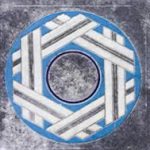Eric Nelsons Ancient Life Symbols adds a distinctive ornamentation throughout the Environmental building that compliments many of the natural aspects of the other exhibits displayed. Its bright colors mimic the colors throughout the rest of the building painting the intricate visible pipes that run through the center of the building. The patterns in the works seem to emulate the geometry of nature. Reminding its audience of cellular repetition, insects, and snowflakes. The pieces are scattered around the building in several areas and various levels. They are placed with subtlety and indistinctly that reflects the work itself. The WWU Environmental building is as much an exhibit of natural items as it is a space for learning about the earth, the environment and natural sciences. The building features large windows, abundant plants, fossil specimen, rock specimen and a circular design that similar to a gallery encourages the students to observe the displays as they walk to class.
Eric Nelson was born in 1954 in Seattle, Washington. He is known for his symbolic ceramic sculptures fired in a unique anagma kiln. Nelson studied in Japan for several years, perfecting this method of ceramic making in the ancient wood-fired kiln, before building his own kiln behind his studio on Vashon Island, where he currently resides. To accomplish this, he “stacks the long, domed brick chambers for the week-long firing process only twice a year, calling on all the help he can muster to keep the fire properly stoked”.The ash from the wood in the kiln creates a richly-textured, imperfect glaze that is recognizable in his work for its embodiment of the natural elements used. As a testament to his decades of success, Nelson has been featured in over fifty exhibitions, with at least seventeen dedicated to his work alone. His artwork has been featured in numerous galleries, such as the William Traver Gallery in Seattle, Washington and the Museum of Northwest Art in LaConner, Washington. While the majority of Nelson’s art has been showcased in the Pacific Northwest, some of his work has made it as far as the Vermont Clay Studio in Waterbury Center, Vermont and the ASU Museum of Art in Phoenix, Arizona. Similarly, Eric Nelson has been featured in over forty articles regarding his ceramics and his relevance to the Pacific Northwest arts community.
Artists are often influenced by their environment and the current political and social climates. Given that Eric Nelsen was inspired by “the human journey” it’s probable that Eric Nelsen was influenced by events happening before and around 1975, the year his works were made and installed in the Environmental building here at Western Washington University. The art receives a new context when viewed considering local and national events. A few to consider include the fourth quarter of the Vietnam War, the aftermath of the civil rights movement and significant findings within science and technology; all which had a profound influence on American art and culture.
Photography by Anselmo Cristobal
Research by Grace Schmidt, Taylor Brown and Anselmo Cristobal
Sources:
-
Bengal, Tom. “Power for the People.” The Northwest Passage 2 (1992): page. 21
-
“Don’t mess with their body.” The Northwest Passage 2 (1992): pages. 6, 7
-
Pedersen, Brynne. “Thinking of Dreams.” The Northwest Passage 3 (1992): page. 29
-
Pedersen, Brynne. “All My Trails, Lord.” The Northwest Passage 3 (1992): page. 31
-
Ament, Deloris Tarzan. “Northwest Ceramics: Still Alive in Our Affections.” Artguide Northwest — Northwest Ceramics. Art Guide Northwest, 1 Dec. 1998. Web. 25 Apr. 2017.
-
“Eric Nelsen Art at the Traver Gallery.” Traver Gallery. Traver Galley, n.d. Web. 26 Apr. 2017.







Leave a Reply